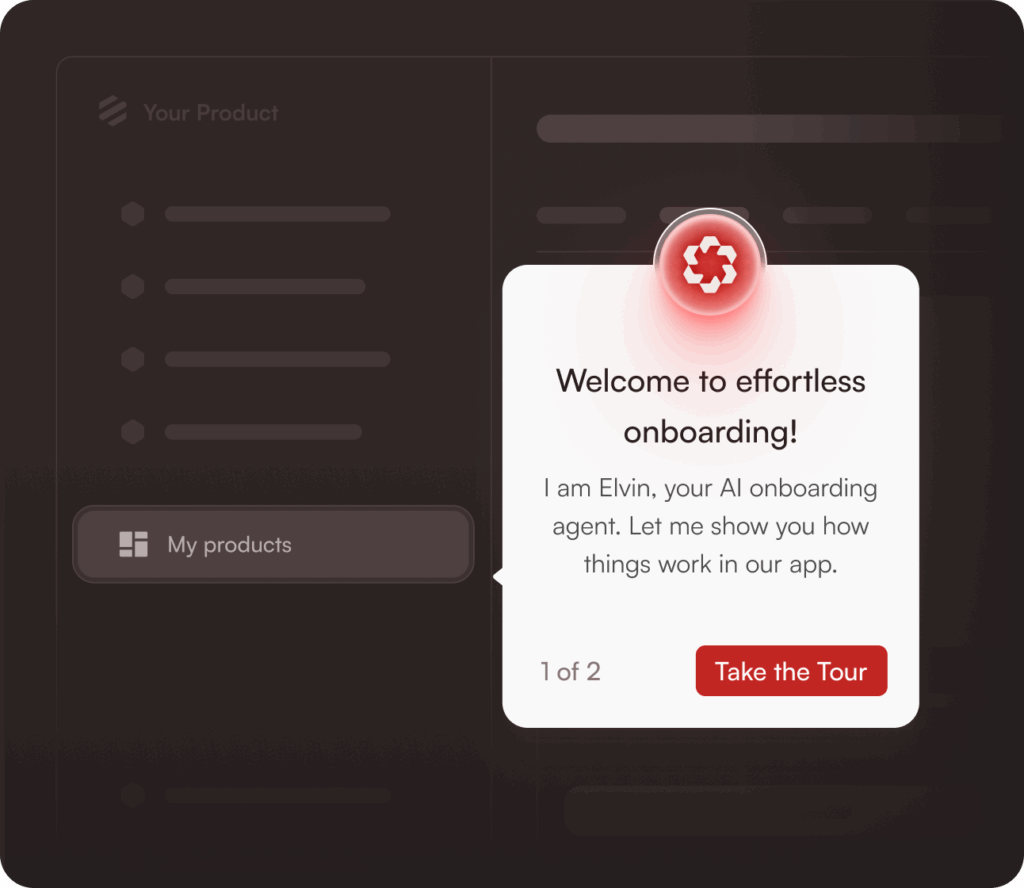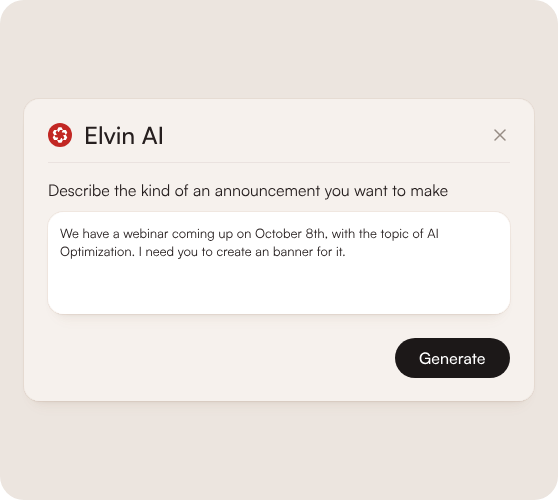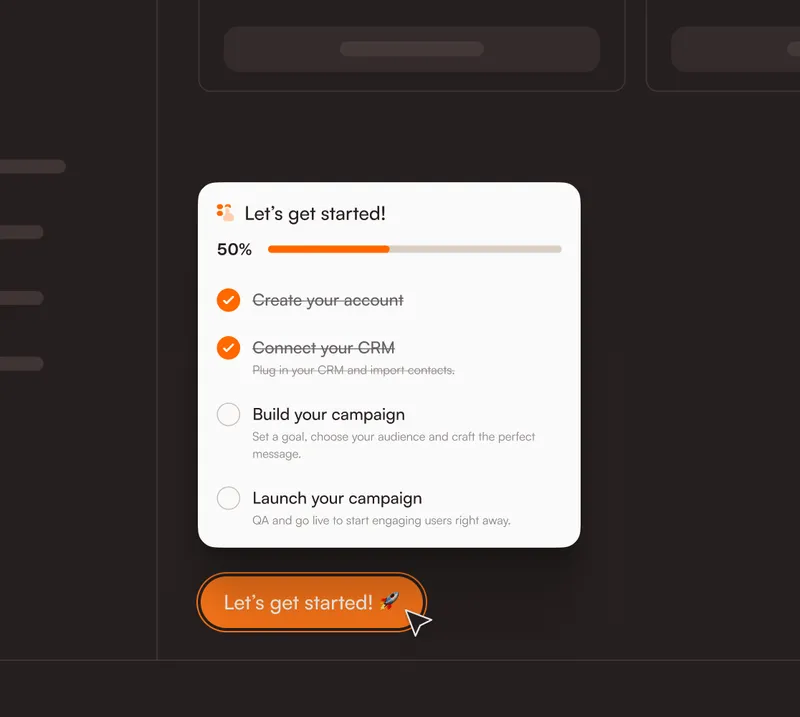
Picture this: You’ve just rolled out a feature that took your team months to build. You’re confident it’ll solve real problems for your users. Launch day arrives and… crickets. Your analytics show a measly 8% adoption rate after the first week.
Sound familiar?
The benchmark for a good feature adoption rate in B2B SaaS is 28% —meaning only 28% of a product’s features are regularly used. The rest? Digital dust collectors.
But what if, instead of building yet another static product tour or dumping users into a help center maze, you could deploy an AI agent that understands context, anticipates friction, and can actually do things on behalf of your users?
Welcome to 2025, where AI agents have gone from experimental novelty to mainstream product strategy. Seventy-nine percent say AI agents are already being adopted in their companies, and of those adopting AI agents, two-thirds (66%) say that they’re delivering measurable value through increased productivity
This isn’t about chatbots that regurgitate your FAQ page. We’re talking about intelligent systems that can guide users through workflows, execute multi-step tasks, generate personalized onboarding content, and surface insights about why adoption is lagging—all without writing a single line of code.
In this guide, we’ll break down the AI agent landscape for product adoption: what these agents actually are, which problems they solve, the types you can deploy today, and how to evaluate and pilot them without betting the farm.
Let’s dig in.
Let’s start with a definition that actually means something.
An AI agent is software that can understand goals, plan steps, use tools, and take actions—not just answer questions. Think of it as the difference between a tour guide who reads from a script versus one who notices you’re lost, asks where you’re trying to go, checks the map, and walks you there.
Traditional product tours and tooltips? One-way streets. They show preset steps in a fixed order. You click “Next,” “Next,” “Got it,” and hope users actually got it.
Chatbots retrieve answers from your knowledge base. Helpful, but passive. They wait for you to ask the right question (which assumes you know what to ask in the first place).
AI agents change the game:
This isn’t fringe tech anymore. Microsoft launched a dedicated AI Agents hub with agent “success kits.” Adobe unveiled the Agent Orchestrator and ten pre-packaged AEP agents. Oracle announced a native AI Agent Marketplace embedded right into Fusion Applications.
With 78 percent of companies indicating they plan to implement AI agents, AI’s benefits and economic impact will likely only continue to increase (Enterprise AI Agents: The Next Phase of Digital Business Transformation | BSA TechPost) (Enterprise AI Agents: The Next Phase of Digital Business Transformation | BSA TechPost). In fact, 96% plan to expand in 2025 (10 AI Agent Statistics for Late 2025).
Translation: If you’re not at least experimenting with agents for product adoption, you’re already behind.
Let’s get tactical. What can agents actually do to move the needle on adoption?
Your users don’t have time to wade through a 47-step onboarding checklist. Agents proactively route them to the “aha” moment, answer context-specific questions from your help center, and—if you deploy action agents—can even perform the next step for them.
Cutting Time-to-Value (TTV) is one of the most proven levers in product-led growth. The median activation rate is 17%, while the 90th percentile rate is 65%. Agents help you climb toward that top tier.
Imagine you’re a new user logging in for the first time. Instead of a wall of tooltips interrupting every click, an agent waits for a natural pause and then nudges you: “Ready to set up your first project?”
That’s context-aware guidance. It doesn’t treat every user like a beginner or spam power users with basics they already know.
Doc-grounded assistants resolve routine “Where is X?” or “How do I Y?” questions instantly. When confidence is low or the query is outside the knowledge base, they hand off to a human. This keeps support queues lean and users unblocked.
Deflection is a measurable support metric—and agents are purpose-built for it.
Here’s where it gets powerful: Insight agents surface stuck points—funnel drop-offs, underused features, low-engagement cohorts—and trigger targeted in-app interventions in the same platform. No more running reports in one tool, brainstorming fixes in another, and building guides in a third.
You identify friction and fix it, all in one motion.
Let’s break down your options, from easiest to implement to most advanced.
What they do: Deliver contextual tips, product tours, and microsurveys with precise triggers—on click, hover, time-delay, or Smart Delay (which waits for natural pauses in user activity). Some can even summarize open-ended feedback using AI.
Best for: Reducing interruption fatigue, driving feature discovery, collecting qualitative feedback at scale.
How does Product Fruits help you with this: Product Fruits AI lets teams deploy hints/tooltips and feature tours that appear exactly when users hesitate or interact with specific areas. Elvin AI flags friction points, while you control copy, placement, and timing so prompts feel native, not generic. You can trigger content by user behavior or context (e.g., pausing, entering a section, touching a feature outside their plan), and segment by plan, language, or role to ensure relevance. Microsurveys (like NPS or short qualitative questions) launch in‑app at the right moment to capture intent without sending users elsewhere. This all runs from a single JS install, with one‑click publishing and no ongoing developer tickets.
Quickest to ROI: Yes. Low-code, fast setup, immediate impact on activation funnels.

What they do: Answer questions from your website, docs, or knowledge base. Collect thumbs-up/down ratings. Escalate to a human or create a support ticket when the agent can’t help. Provide usage analytics and cost controls.
Best for: Self-service deflection, 24/7 support, reducing time-to-answer.
How does Product Fruits help you with this: Product Fruits embeds an in‑app copilot that lives inside your product. When users ask questions, Elvin Copilot searches connected sources—your knowledge base, documentation, and website/blog—to deliver precise, conversational answers right where they work. You can annotate key product areas so Elvin AI knows it and can generate individual, on-demand step‑by‑step tours when a “how do I…?” question needs guided navigation. It supports multiple languages, keeps recent conversation history for context, and collects feedback on answers to improve quality over time.
Quickest to ROI: Yes, especially if you have solid documentation. Setup can take less than a day.

What they do: In‑app announcements are newsfeeds, pop‑ups, and banners shown directly in your product. They ensure users see updates where they work, and can launch tours to learn features immediately. Targeting by role/plan and scheduling prevents noise while accelerating adoption.
Best for: SaaS teams that need users to notice and act on updates without email or engineering bottlenecks.
How does Product Fruits help you with this: Product Fruits provides newsfeeds, pop‑ups, and banners with smart targeting (role, plan, URL) and scheduling (repeat until seen). Elvin AI can generate announcements from your brief, and you can attach product tours so users not only see changes but learn them right away—published in minutes and without code.
Time Saved: By removing dev tickets and auto‑generating content, teams go from drafting to publishing in minutes instead of days. Scheduling and “repeat until seen” automate timing, while tour attachments cut back-and-forth training—saving hours of manual rollout and support.

What they do: Personalized onboarding tailors guidance to a user’s goals and progress, adapting steps as they move through your product. It delivers help in context—when users ask “how do I…?” or trigger key actions—so they reach “Aha!” moments sooner. This reduces drop‑off, increases completions, and accelerates time‑to‑value with less manual setup.
Best for: Teams with evolving products that need scalable, in‑app guidance without heavy engineering.
How does Product Fruits help you with this: Product Fruits’ Elvin AI learns your product from a one‑time annotation, then automatically generates tours tailored to each user’s goals and current state. Tours can be delivered in conversation (when users ask questions) or triggered by actions/contexts, and they’re easy to adjust when your UI changes—no coding or selector wrangling. You stay in control of copy, placement, and timing, while Elvin handles the heavy lifting so onboarding feels native and timely.
Time savings: Rmoves manual tour building and rework by creating and updating tours automatically, cutting setup and maintenance time dramatically. Onboarding has been shown to run 29% faster—for example, 17 minutes down to 12. How Keboola Accelerated its User Onboarding by 29% ↗

What they do: Embed your knowledge base contextually so articles appear where users get confused, not in a separate help site. Elvin understands plain language, typos, and intent, turning queries into natural, relevant answers inside the workflow. Faster “find, not search” reduces friction, helping users complete tasks and adopt features sooner.
Best for: SaaS teams with rich documentation who want self‑serve support that drives product adoption without adding support load.
How does Product Fruits help you with this: Product Fruits’ AI‑powered knowledge base delivers answers in context through contextual embedding, organizes content around user behavior, and supports rich formats (screenshots, videos, step‑by‑steps). Flexible access control lets you target internal vs. public content by role or permission, while Elvin turns docs into conversational answers, improving relevance over time through adaptive learning. Real‑world impact includes reduced support load, such as a 25% ticket reduction.
ROI angle: Users stop hunting across pages and get answers immediately where they work, cutting “ticket marathons” and back‑and‑forth clarifications. Support teams spend fewer cycles on repetitive questions; product teams publish and update rich guides once, then surface them automatically—saving hours otherwise lost to triage and manual routing.

What they do: Trigger surveys right after key actions so feedback is fresh and tied to behavior. Branching adapts questions per response, revealing why users drop off or love features. Segment by role/plan to spot patterns and prioritize improvements that drive adoption.
Best for: Product, UX, and Customer Success teams that need in‑app, context‑aware feedback without engineering overhead.
How does Product Fruits help you with this: Product Fruits’ AI‑powered NPS & surveys let you state your goal and have Elvin generate polished, on‑brand surveys with targeting, timing, and adaptive branching. Surveys are triggered by context, personalized per user role, and easy to refine as priorities change, so you capture churn signals and satisfaction drivers exactly where users work—and act on them to improve adoption.
When to consider: Surveys are created and ready to launch in minutes, with no templates or coding. Scheduling and “go live right away” remove manual coordination, while adaptive flows cut follow‑up cycles—saving hours otherwise spent drafting, targeting, and distributing surveys.

Choose Product Fruits if: You’re a startup or mid-sized SaaS looking for the most cost-effective, all-in-one solution It offers AI-powered tours, onboarding checklists, feedback widgets, announcements, and an integrated knowledge base—no code required. Rated 4.7 on G2 for exceptional support and best value-for-money in the market.
Choose Appcues if: You want a mobile-first onboarding platform with a clean drag-and-drop builder and ready-to-use UI templates. Ideal for product teams prioritizing intuitive UX and quick deployment.
Choose Chameleon if: You need visually polished, hyper-customized tours and tooltips ($279+/month) with full on-brand control and advanced targeting rules.
Choose UserGuiding if: You want fast setup, pre-built templates, and simple pricing ($174+/month). Build checklists, tooltips, and modals without developers.
Choose Whatfix if: You’re an enterprise seeking localization, governance, and analytics at scale. Works across multiple web apps with strong change management support.
Choose Userflow if: You need fast deployment, high customization, and lightweight SDK performance. Setup can take under a day, ideal for agile teams.
Vendor demos are great—until you realize the glossy experience doesn’t map to your messy reality. Here’s a 10-question checklist to separate signal from noise.
Example: “Fire this tip when a user reaches 5 logins but hasn’t used Feature X.”
Look for platforms that unite analytics and guidance (e.g., Whatfix, Product Fruits, Pendo).
Support deflection is table stakes. Ask: “Can you show me a case study where activation rate or TTFV improved by X%?”
Anchor to product analytics baselines. The average adoption rate across all sectors was 24.5%, and the median was 16.5% (Core Feature Adoption Rate: Benchmark Report 2024). Demand proof that the agent moves those numbers.
Can you give agents least-privilege access? Log/audit every action? Integrate with your SSO? Align to NIST AI Risk Management Framework governance guidance.
SOC 2? GDPR/CCPA alignment? Data residency controls? If your product touches healthcare, finance, or EU users, this is non-negotiable.
What happens when the agent’s model provider goes down (or AI credit cap is reached)? Can it degrade gracefully and escalate to human help?
Does the agent auto-train from docs/KB updates? Or do you manually re-upload every time you update a help article?
Computer-use agents should be resilient to UI changes (e.g., button labels shifting).
Can you see every agent interaction? Which answers users rated helpful? Where the agent said “I don’t know”?
Can agents call tools/APIs? This matters if you plan to scale beyond one agent.
Activation is a one-time milestone that proves initial value (e.g., first integration). Adoption is ongoing, habitual use where the feature becomes part of the workflow. Aim to optimize both, in that order.
Benchmarks hover around ~6–7% median for most products. “Good” is beating your own baseline by segment and steadily compounding: new feature → 14/30/60-day adoption → retained usage.
Reduce friction to first value. Use a DAP to add checklists, targeted tours, and tooltips; pair with analytics to remove blockers; nudge next-best actions with in-app messages; validate with experiments.
Use a DAP to guide users (tours, checklists, nudges) right now. Use analytics to find where and why users drop off, then measure whether the guidance worked. They’re complementary, not substitutes.
AI agents personalize onboarding, detect hesitation in real time, and offer context-aware help. They answer routine questions, route complex ones to humans, and learn which guidance drives completion and retention.
Product Fruits is a no-code DAP with AI-assisted onboarding, checklists, tooltips, announcements, and surveys. It’s ideal for SMB and mid-market teams that need to ship guidance fast and iterate without dev cycles.
Track: Activation Rate, Feature Adoption Rate, Time-to-Value (TTV), Stickiness (DAU/MAU), PES, and support ticket volume. Report lift vs. control cohorts and watch 14/30/60-day retention.
A 3-step checklist to first value, one targeted tour per must-do action, tooltips on tricky UI, and an in-app help hub with FAQs. Add a micro-survey at the biggest drop-off to capture “why.”
Run an experiment: expose 50% to the new onboarding. Show Δ TTV, Δ feature adoption, Δ retention, and ticket reduction. Convert gains to revenue (expansion + churn saved) minus tool cost.
Shipping tours without analytics, one-size-fits-all onboarding, long autoplay tours, no experiments, ignoring feedback, and treating adoption as a launch task instead of a weekly operating cadence.
With a no-code DAP, your first live guide/checklist can ship in days. Full coverage is iterative: start with the must-do path, then expand by segment and feature.
Look for SSO, audit logs, approvals, WCAG accessibility, SDK performance, and localization. If you’re global or regulated, prioritize these in your vendor short-list.